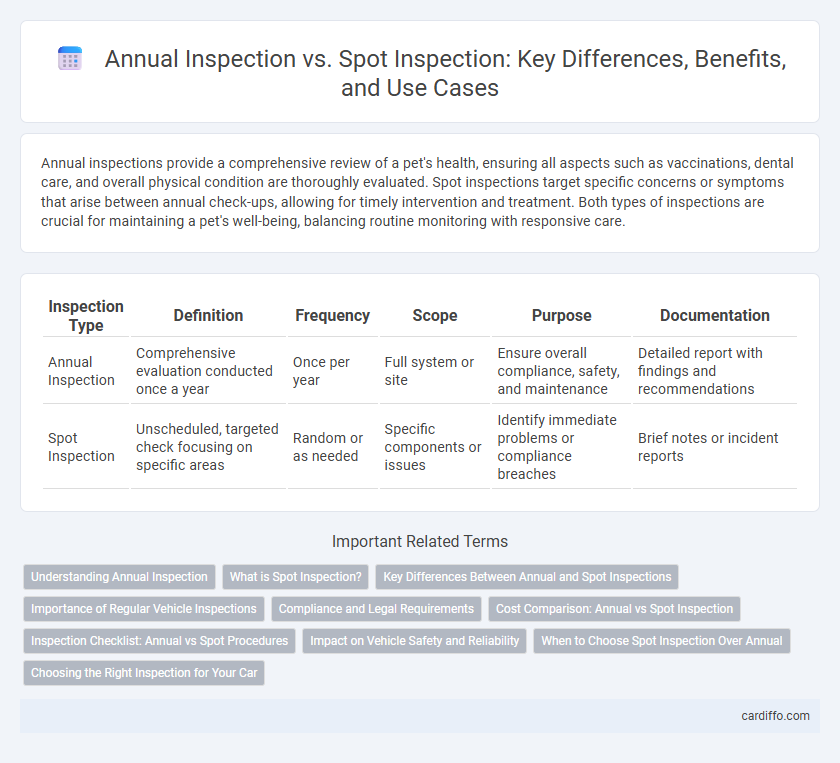Annual inspections provide a comprehensive review of a pet's health, ensuring all aspects such as vaccinations, dental care, and overall physical condition are thoroughly evaluated. Spot inspections target specific concerns or symptoms that arise between annual check-ups, allowing for timely intervention and treatment. Both types of inspections are crucial for maintaining a pet's well-being, balancing routine monitoring with responsive care.
Table of Comparison
| Inspection Type | Definition | Frequency | Scope | Purpose | Documentation |
|---|---|---|---|---|---|
| Annual Inspection | Comprehensive evaluation conducted once a year | Once per year | Full system or site | Ensure overall compliance, safety, and maintenance | Detailed report with findings and recommendations |
| Spot Inspection | Unscheduled, targeted check focusing on specific areas | Random or as needed | Specific components or issues | Identify immediate problems or compliance breaches | Brief notes or incident reports |
Understanding Annual Inspection
Annual inspections involve comprehensive evaluations conducted on a scheduled basis, ensuring all aspects of equipment, facilities, or processes meet regulatory and safety standards. These inspections provide detailed documentation, helping to identify potential long-term issues and maintain operational integrity. Understanding annual inspections is crucial for effective maintenance planning and compliance adherence.
What is Spot Inspection?
Spot inspection is an unplanned, random evaluation conducted to verify compliance with regulations or standards without prior notice. It targets specific areas or procedures to identify potential issues or deviations quickly and efficiently. Unlike annual inspections, spot inspections provide real-time snapshots of operational conditions, enhancing overall quality control and risk management.
Key Differences Between Annual and Spot Inspections
Annual inspections involve comprehensive, scheduled evaluations that assess overall compliance and long-term condition, while spot inspections are unscheduled, focused checks targeting specific issues or areas of concern. Annual inspections provide a detailed, holistic overview and often include documentation and reporting, whereas spot inspections prioritize rapid identification of immediate risks or non-compliance. The key difference lies in frequency, scope, and purpose: annual inspections ensure ongoing maintenance and preventive care, spot inspections address urgent or unforeseen problems.
Importance of Regular Vehicle Inspections
Regular vehicle inspections, including annual and spot inspections, are essential to ensure road safety and prevent mechanical failures. Annual inspections provide a comprehensive evaluation of a vehicle's condition, helping identify potential issues early, while spot inspections offer targeted checks based on specific risks or complaints. Maintaining a consistent inspection schedule reduces the risk of accidents, extends vehicle lifespan, and ensures compliance with safety regulations.
Compliance and Legal Requirements
Annual inspections ensure comprehensive compliance with regulatory standards by systematically evaluating all operational aspects at scheduled intervals, minimizing legal risks. Spot inspections target specific areas or issues, providing immediate verification of compliance and enabling rapid identification of violations. Both inspection types are critical for maintaining ongoing adherence to legal requirements and preventing potential penalties or enforcement actions.
Cost Comparison: Annual vs Spot Inspection
Annual inspections often involve higher upfront costs due to comprehensive evaluations and scheduling, but they can prevent costly repairs by identifying issues early. Spot inspections typically incur lower immediate expenses as they target specific concerns or occurrences, however, they may lead to higher long-term costs if underlying problems go undetected. Comparing the two, annual inspections provide a cost-efficient preventive approach, while spot inspections serve as reactive solutions with potentially variable financial impacts.
Inspection Checklist: Annual vs Spot Procedures
Inspection checklists for annual inspections are comprehensive, covering all equipment components and safety standards with detailed procedural steps and documentation requirements. Spot inspection checklists focus on critical, high-risk areas and essential safety checks, emphasizing quick verification over exhaustive evaluation. Annual procedures involve systematic, scheduled tasks to ensure long-term compliance, while spot procedures prioritize immediate identification of visible defects or hazards.
Impact on Vehicle Safety and Reliability
Annual inspections provide a comprehensive evaluation of vehicle safety and reliability by systematically checking critical components such as brakes, tires, and engine systems, ensuring long-term performance. Spot inspections target specific issues or random checks, offering immediate detection of faults but lacking the thoroughness of an annual review. Combining both inspection types enhances overall vehicle safety by addressing both routine maintenance and unexpected problems promptly.
When to Choose Spot Inspection Over Annual
Spot inspection is preferred over annual inspection when immediate assessment of specific concerns or irregularities is required, such as unforeseen damage or safety hazards. It enables targeted evaluation without waiting for the routine yearly schedule, ensuring timely corrective action and reducing potential risks. Spot inspections are also effective in high-risk environments where continuous monitoring is essential for compliance and operational safety.
Choosing the Right Inspection for Your Car
Annual inspections provide a comprehensive evaluation of your car's overall condition, ensuring all systems meet safety and emissions standards as mandated by local regulations. Spot inspections target specific components or issues, offering a faster, cost-effective solution when symptoms or concerns arise between annual checks. Selecting the right inspection depends on your vehicle's history, mileage, and any warning signs noticed, balancing thoroughness with convenience and cost.
Annual Inspection vs Spot Inspection Infographic

 cardiffo.com
cardiffo.com